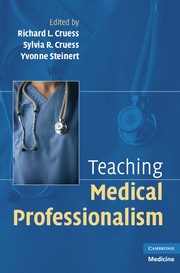Book contents
- Frontmatter
- Contents
- List of Contributors
- Foreword by William M. Sullivan
- Introduction
- PART ONE WHAT IS TO BE TAUGHT
- PART TWO THEORY
- 2 Educational Theory and Strategies for Teaching and Learning Professionalism
- 3 Professionalism and the Socialization of Medical Students
- PART THREE PRINCIPLES
- PART FOUR PRACTICE: CASE STUDIES IN TEACHING PROFESSIONALISM ACROSS THE CONTINUUM
- APPENDIX A Definitions of Professionalism
- APPENDIX B Core Attributes of Professionalism
- APPENDIX C The Teaching of Professionalism: Vignettes for Discussion
- APPENDIX D A Matrix for “Matching” Teaching Methods to Attributes
- APPENDIX E Sample Grid for Use with Discussion of Vignettes
- APPENDIX F Sample Questions to Guide Discussion about the Social Contract: Small-Group Leaders' Guide with Suggested Responses
- APPENDIX G Professionalism Program for Residents: Suggested Outline for Small Group Facilitators
- APPENDIX H Sample Evaluation Form for Residents' Half-Day Program on Professionalism
- Index
- References
3 - Professionalism and the Socialization of Medical Students
Published online by Cambridge University Press: 01 September 2009
- Frontmatter
- Contents
- List of Contributors
- Foreword by William M. Sullivan
- Introduction
- PART ONE WHAT IS TO BE TAUGHT
- PART TWO THEORY
- 2 Educational Theory and Strategies for Teaching and Learning Professionalism
- 3 Professionalism and the Socialization of Medical Students
- PART THREE PRINCIPLES
- PART FOUR PRACTICE: CASE STUDIES IN TEACHING PROFESSIONALISM ACROSS THE CONTINUUM
- APPENDIX A Definitions of Professionalism
- APPENDIX B Core Attributes of Professionalism
- APPENDIX C The Teaching of Professionalism: Vignettes for Discussion
- APPENDIX D A Matrix for “Matching” Teaching Methods to Attributes
- APPENDIX E Sample Grid for Use with Discussion of Vignettes
- APPENDIX F Sample Questions to Guide Discussion about the Social Contract: Small-Group Leaders' Guide with Suggested Responses
- APPENDIX G Professionalism Program for Residents: Suggested Outline for Small Group Facilitators
- APPENDIX H Sample Evaluation Form for Residents' Half-Day Program on Professionalism
- Index
- References
Summary
History is opaque. You see what comes out, not the script that produces events, the generator of history.
INTRODUCTION
In this chapter, we will examine issues of professions and professionalism through a particular lens, socialization theory. The fundamental assumption driving this chapter is my belief that current discussions about professionalism contain a bevy of unexamined assumptions about what happens to trainees as they move from the social and social-psychological status of lay outsiders to full members in a particular occupational group, in this case, medicine. These tacit renderings, in turn, block or otherwise distort meaningful efforts by medical educators to link medical training with principles and practices of professionalism. Until these disconnects and contradictions are pinpointed and made more explicit, efforts to develop targeted and effective educational interventions will continue to be thwarted.
To facilitate this examination, I treat medicine's current professionalism movement as discourse and analyze “how the specialized language of academic medicine disciplines has defined, organized, contained, and made seemingly immutable a group of attitudes, values, and behaviors subsumed under the label of professionalism.” My principal focus will be on the discourse of professionalism that has emerged since the mid-1980s, a period I consider organized medicine's “modern day professionalism movement.” For analytical reasons discussed below, I label this discourse “nostalgic professionalism.” This discourse is marked by calls for physicians to recommit themselves to an ethic of professionalism – an ethic grounded in selfless service (e.g., altruism) and an ethic calling for the transformation of practitioners at the level of core value and self-identity.
- Type
- Chapter
- Information
- Teaching Medical Professionalism , pp. 53 - 70Publisher: Cambridge University PressPrint publication year: 2008
References
- 40
- Cited by



